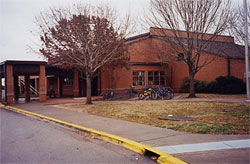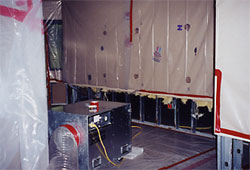Austin Mold
Air Date: Week of January 25, 2002
Mold is an increasing problem in schools across the country. Many students and staff are complaining of health problems and it’s costing school districts a lot of money to remove the mold. Janet Heimlich reports on a school district in Austin, Texas that’s struggling to pay for testing and mold removal at three schools.
Transcript
CURWOOD: Molds are a type of fungus, and out in nature molds play an important role in breaking down dead and decaying matter. But if they get inside buildings, mold toxins and reproductive spores can lead to serious illnesses, including sinus infections and asthma attacks. In Texas, the Austin Independent School District has been hard hit by mold, and its removal is running into the millions of dollars. Janet Heimlich reports.
HEIMLICH: Robin Sykes' daughter, Caroline, is in the fourth grade at Patton Elementary School in Southwest Austin. Ms. Sykes says Caroline has been getting occasional headaches since the first grade, but they were never very bad.
SYKES: Near last spring, though, I noticed the headaches began to become more severe. She complained about them practically every afternoon. And the only thing that would make them go away was to take Motrin and lie down for a couple of hours. So I became concerned.
 Patton Elementary School, Austin, Texas.
Patton Elementary School, Austin, Texas.(Photo: Janet Heimlich)
[SCHOOL AMBIENT SOUNDS]
HEIMLICH: As you walk down the halls of Patton Elementary School, you notice that some classrooms have been sealed off from the public. Their doors are locked, and plastic sheeting hangs in the doorways. Inside, the rooms have been gutted.
[SOUND OF KEYS, DOOR OPENING]
LAUDERDALE: You can see they've done a little bit in here.
HEIMLICH: Jerry Lauderdale is an indoor air quality consultant hired by the school district to oversee testing in mold removal. The room he is standing in looks like it's under construction. Its sheetrock has been removed from the walls, revealing metal studs with insulation in between. At the base of the walls, a couple of feet of insulation has also been removed. Mr. Lauderdale says it was here that crews found several inches of mold.
LAUDERDALE: Kind of black, splotchy areas of mold growth on the surface of the sheetrock right behind that base trim, in many areas.
 (Photo: Janet Heimlich)
(Photo: Janet Heimlich)BLACK: I can remember, ten years ago, when you went into a school and there was concern about an indoor quality complaint, it was often hard to find the cause. You really had to search very significantly whether it might be a chemical exposure, pesticide exposure. Now when you go in, you can literally see the mold growth.
HEIMLICH: Ms. Black says more schools are being affected now because shrinking budgets make it harder for schools to keep up maintenance and hire good contractors. Some say schools built in the last 20 or 30 years are particularly vulnerable to mold because they're poorly ventilated and have flat roofs which are prone to leaks. Also, numerous schools are lined with sheetrock, which mold likes to feed on. Now, schools are struggling to pay to have the mold removed or rebuild their facilities. Dr. Edward Fuentes is the deputy superintendent who oversees construction and maintenance for the Austin Independent School District. Dr. Fuentes says his district is looking at a bill of about $18 million, to pay for testing and mold removal at three schools.
FUENTES: What's happening is that we have to take the money out of our regular operating funds to fund this stuff, and if you want to pay teachers well enough to keep them, you want to add programs or others, that's competing.
HEIMLICH: To pay to remove mold and fix leaks in some 90 schools, the Austin School District has introduced a $49 million bond measure. It will be voted on February 2nd. But despite the financial pains, the problem has brought to light the possible health effects of indoor mold. It's known that people who are allergic to outdoor mold suffer with sinus congestion, watery itchy eyes, and other symptoms. But when mold gets inside a building, it can affect even those who have no known allergy to mold. Dr. David Straus is a professor of microbiology and immunology at Texas Tech University Health Sciences Center in Lubbock.
STRAUS: What's different about being inside of a building, of course, as opposed to outside, is that as these organisms grow in the building, their concentrations increase. It's really just like them living in a box.
HEIMLICH: In 1998, Dr. Straus completed a study of 48 Texas schools with mold problems. He interviewed the staff before and after mold was removed. Dr. Straus says after the mold was gone complaints of health problems dropped significantly.
STRAUS: There was an absolute correlation between the presence of these organisms in the building and the phenomenon we refer to as sick building syndrome.
HEIMLICH: Dr. Straus says some molds are more toxic than others. It's still unproven whether these molds cause such serious ailments as bleeding lungs and memory loss. At Patton Elementary School researchers found a number of different kind of toxic molds. Last year, administrators and others doubted mold was making people sick, but today you'll find few skeptics at Patton.
Robin Sykes, whose daughter was having bad headaches, says Caroline got better when summer came around and she was away from school. Teacher Michael Massed says before mold was found in his classroom and he and his third graders were moved to a different space, he had had a persistent cough and nasal drip.
MASSED: I still really couldn't quite bring myself to say yes, it's because of the mold, but since I've moved out here I have clearly felt a lot better. I haven't been to the doctor once. So now I'm thinking, while it's still unscientific, I have to think that it had something to do with being removed from that environment.
HEIMLICH: Mr. Massed says he hopes the bond measure to renovate Austin schools will pass. That way, the district will have enough money to pay for both important educational programs and a safer environment. For Living on Earth, I'm Janet Heimlich in Austin.
CURWOOD: And you're listening to NPR's Living on Earth.
Links
Living on Earth wants to hear from you!
Living on Earth
62 Calef Highway, Suite 212
Lee, NH 03861
Telephone: 617-287-4121
E-mail: comments@loe.org
Newsletter [Click here]
Donate to Living on Earth!
Living on Earth is an independent media program and relies entirely on contributions from listeners and institutions supporting public service. Please donate now to preserve an independent environmental voice.
NewsletterLiving on Earth offers a weekly delivery of the show's rundown to your mailbox. Sign up for our newsletter today!
 Sailors For The Sea: Be the change you want to sea.
Sailors For The Sea: Be the change you want to sea.
 The Grantham Foundation for the Protection of the Environment: Committed to protecting and improving the health of the global environment.
The Grantham Foundation for the Protection of the Environment: Committed to protecting and improving the health of the global environment.
 Contribute to Living on Earth and receive, as our gift to you, an archival print of one of Mark Seth Lender's extraordinary wildlife photographs. Follow the link to see Mark's current collection of photographs.
Contribute to Living on Earth and receive, as our gift to you, an archival print of one of Mark Seth Lender's extraordinary wildlife photographs. Follow the link to see Mark's current collection of photographs.
 Buy a signed copy of Mark Seth Lender's book Smeagull the Seagull & support Living on Earth
Buy a signed copy of Mark Seth Lender's book Smeagull the Seagull & support Living on Earth

